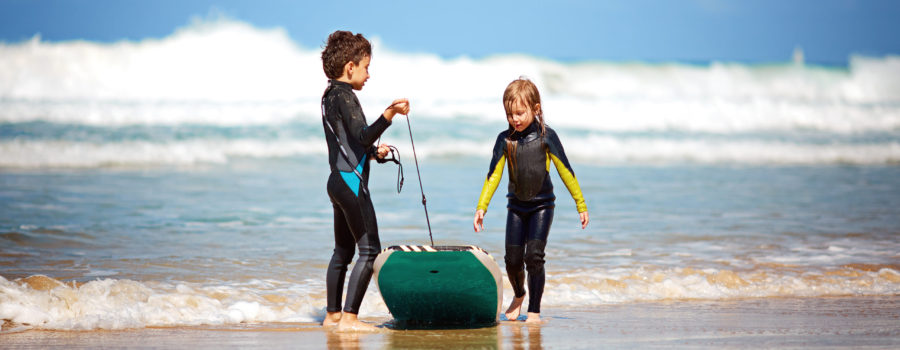Every summer for many years our extended family would get together for a fun beach day. The 8 cousins were all within a 7-year range and enjoyed playing together in the water and on the sand. The youngest child, Luke, had autism with intellectual delays, and was just as much a part of the clan as the rest of the children.
If you have been to a beach at the ocean you know that the waves come and go in a rhythmical motion that moves swimmers along the beachfront. Where the swimmer enters is not where they emerge after riding a wave onto shore. Beach lovers are keenly aware of this phenomena and families take measures to teach their swimmers how to identify markers on the beach to locate the family campsite and keep from getting too far away. This training is also accompanied with instructions to run back to a specific entry spot on the beach each time the kids ride a wave ashore. The year Luke became old enough and skilled enough to swim with his sister and cousins I took the kids to the beach early in the morning so I could teach Luke the rules of the water with as few distractions as possible. Swimming together, I helped Luke learn to use a body board and took careful steps to teach the routine of always checking his position on the beach, never going too far, and returning to the starting point every time. I went the extra step to place specifically identifiable chairs at the, “enter the water here,” and, “do not go past here,” point on the sand. I swam with the kids, then watched carefully and instructed attentively until I felt Luke understood the rules. As I relaxed my diligence, I sat down within view but a little further away. All was going well. Luke’s sister and older cousins agree to remind him to follow the beach rules and stay with the group. Running up the beach, pulling their body boards behind them by the bungie cord, the kids were laughing while learning to control their boards as they would sometimes catch a burst of wind and swing about wildly. Everyone was having fun swimming, body boarding, and running.
As the day progressed more families and more children started to arrive. Realizing that more children on the beach posed a potential danger for the wildly flying boards to hit another child, I cautioned the children. Hollering out to them, “Be careful! Watch-out for others,” served to adjust the behavior of the older children. On the next run up the beach the younger children were still dragging their boards by the string and I stopped them to show how the board was swinging in the air and could be dangerous. Reminding them again, “Be careful” and “Don’t hurt anyone,” I release the group back to play. Once again, the children returned running up the shoreline. With the exception of little Luke, all of the children had adjusted how they carried their boards and were cautions of other children playing on the beach. Luke was laughing and running with his cousins when his board caught a draft and flinging to the side almost hit a very young girl in the face. Many adults in the area gasped at the near miss and I moved quickly to approach Luke. Some folks, who were not even the little girl’s family, were exceedingly rude yelling at the Luke to stop running and commenting in my direction that the little boy with the bodyboard is obnoxious and mean. Ignoring the ignorance of the few, yet acknowledging my responsibility to promote safety in play, I stopped Luke as he ran. I understood that Luke had no clue that the body board he was dragging behind him was swinging around in an unsafe manner. He did not see the other child almost get hit by his board. He did not understand that the people on the beach were yelling at him. They were not his family. They have no place in his attention. And, while he was cooperative in previous moments of instruction, he did not understand my abstract explanations and requests to “Be Careful, “watch-out”, and “don’t hurt anyone.” Luke only understood that he was running, playing, and swimming. When I stopped just him, as his sister ran ahead, he became a little anxious. So, I asked his sister to wait while I spoke to Luke pointing out all the good things he was doing. “Luke, Hi Five, you are playing so nice. You are staying with your cousins and sister, you are coming back to the chair to go into the water, you are stopping when I call you. Thank You!” Then, I instructed him BETTER. Asking him to “Be Careful,” “Watch-out,” and, “don’t hurt anyone,” are non-specific requests. To better communicate with Luke, I showed him exactly how to hold the body board when running with it. With this, he held on to the board tightly and ran ahead to the group waiting for him.
THAT’S IT! It only took ONE proper instruction of What TO DO to help Luke be safe while playing at the beach – that day and every beach trip thereafter. This lesson stuck with me and informed my interactions with many children with autism. Speaking to Luke in a way that helped him play safely and independently was the best moment of the entire day.
For more information on how to improve your communication with autistic children check out my book Understanding the Challenge of “No” for Children with Autism: Improving Communication, increasing Positivity, Enhancing Relationships.

Find it at MSIPress.com & Amazon




